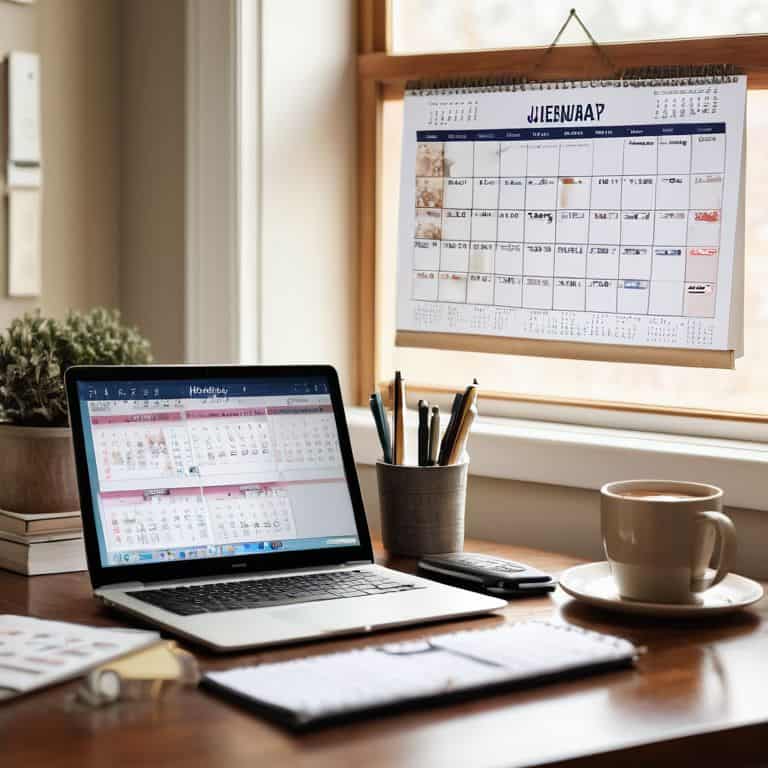I still remember the days when I thought organizing my content was a daunting task. As a former high school tech teacher turned full-time blogger, I’ve learned that using a content calendar template is the secret to streamlining your workflow. I’ve seen many of my fellow bloggers struggle with the concept of how to use a content calendar template, thinking it’s too complicated or time-consuming. But the truth is, it’s a simple yet powerful tool that can help you stay focused and ensure your content gets out to your audience on time, every time.
In this article, I’ll share my personal experience and practical advice on how to use a content calendar template to boost your blogging productivity. You’ll learn how to create a tailored template that fits your unique needs, schedule your content in advance, and make adjustments on the fly. By the end of this guide, you’ll be equipped with the knowledge to turn your content calendar into a roadmap to consistency, helping you build a loyal audience and grow your online presence. Whether you’re a seasoned blogger or just starting out, this article will provide you with the honest, no-hype guidance you need to make the most out of your content calendar template.
Table of Contents
Guide Overview: What You'll Need

Total Time: 1 hour 15 minutes
Estimated Cost: free – $10
Difficulty Level: Easy
Tools Required
- Computer (with internet access)
- Spreadsheet software (e.g., Google Sheets, Microsoft Excel)
Supplies & Materials
- Content calendar template (downloadable or customizable online)
- Marker or pen (for noting important dates)
- Paper or digital planner (for tracking progress and deadlines)
Step-by-Step Instructions
- 1. First, let’s start by understanding what a content calendar template is and why it’s a game-changer for your blogging strategy. A content calendar template is a tool that helps you plan, organize, and schedule your content in advance. It’s essentially a calendar that outlines when and what you’ll post on your blog, allowing you to stay consistent and ensure your content gets out to your audience on time.
- 2. To get started with using a content calendar template, you’ll need to choose a format that works for you. You can use a physical calendar, a digital tool like Google Sheets or Microsoft Excel, or even a specialized content calendar template available online. The key is to find a format that you’re comfortable with and that fits your blogging needs.
- 3. Next, you’ll need to set up your template by adding the necessary columns and rows to track your content. Typically, you’ll want to include columns for the date, post title, category, keywords, and any other relevant details. You can also add rows for each day of the month or week, depending on how often you plan to post.
- 4. Now it’s time to start planning your content. Begin by brainstorming ideas for your blog posts, considering topics that are relevant to your audience and align with your blogging goals. You can use a mind mapping technique or simply jot down ideas as they come to you. Once you have a list of ideas, start assigning them to specific dates on your content calendar template.
- 5. As you fill out your content calendar template, be sure to consider your workflow. Think about how much time you’ll need to write, edit, and publish each post, and schedule accordingly. You may also want to leave some buffer time in case unexpected things come up or posts take longer to complete than anticipated.
- 6. With your content calendar template filled out, it’s time to put it into action. Start by creating a routine for checking and updating your template on a regular basis. This could be daily, weekly, or monthly, depending on your blogging schedule. You’ll also want to set reminders for upcoming posts and deadlines to ensure you stay on track.
- 7. Finally, don’t be afraid to make adjustments as needed. Your content calendar template is a living document that should evolve with your blogging strategy. If you find that your template isn’t working for you, or if your blogging goals change, don’t hesitate to make changes to your template to reflect these updates. The key is to stay flexible and adapt your template to meet your changing needs.
Mastering Content Calendars

As you become more comfortable with your content calendar, it’s time to start mastering content planning strategies. This involves thinking critically about the types of content you want to create, and when you want to release it. Consider your audience’s needs and preferences, and plan your content accordingly. For example, if you know your audience is most active on social media during the morning commute, you can schedule your posts to go live during this time.
To take your content calendar to the next level, consider calendar template customization. This can be as simple as adding or removing columns to fit your specific needs, or as complex as integrating spreadsheets with project management tools. By customizing your template, you can ensure that it meets your unique needs and helps you stay organized. Additionally, look into team collaboration tools for content, which can help you work with others to plan and schedule content.
By following content scheduling best practices, you can ensure that your content is consistently high-quality and engaging. This includes leaving space for spontaneous or timely posts, as well as scheduling regular check-ins to review and adjust your content calendar. Remember to also keep an eye on your visual content calendar examples, to get inspiration for new and creative ways to display your content.
Content Planning Made Simple
Now that we’ve dove into mastering content calendars, let’s simplify the planning process. Content planning is all about creating a roadmap for your content, and it starts with understanding your audience and their needs. By knowing what resonates with them, you can develop a content strategy that speaks directly to their interests.
I like to break it down into smaller, manageable tasks. First, identify your core topics and themes. Then, brainstorm a list of potential content ideas that fit within those categories. Finally, plug them into your content calendar, leaving some buffer room for flexibility and spontaneity. This approach helps ensure your content stays focused, relevant, and engaging, making the planning process much more straightforward.
Customizing Your Calendar Template
Now that we’ve covered the basics of content planning, let’s dive into customizing your calendar template to fit your unique needs. This is where the magic happens, and your content calendar starts to feel truly personalized. You can add or remove columns, change the layout, and even add your own custom fields to track specific metrics or notes.
I like to think of this process as fine-tuning a woodworking project – you’ve got the basic structure in place, but now it’s time to add the details that make it truly special. By customizing your template, you’ll be able to see your content schedule at a glance and make adjustments on the fly, ensuring that your blog stays on track and continues to thrive.
5 Essential Tips to Get the Most Out of Your Content Calendar Template
- Plan Ahead: Schedule Your Content at Least a Month in Advance to Ensure Consistency and Reduce Last-Minute Stress
- Be Flexible: Don’t Be Afraid to Adjust Your Content Calendar Template as Needed – It’s a Living Document That Should Evolve with Your Blogging Strategy
- Keep it Simple: Avoid Overcomplicating Your Content Calendar Template with Too Many Columns or Sections – Focus on the Essentials That Help You Stay Organized
- Make it a Habit: Check and Update Your Content Calendar Template Regularly, Such as Weekly or Bi-Weekly, to Stay on Track and Ensure Nothing Falls Through the Cracks
- Review and Reflect: Regularly Review Your Content Calendar Template to Identify What’s Working and What’s Not, and Make Adjustments to Optimize Your Blogging Strategy and Improve Your Results
Key Takeaways for Mastering Your Content Calendar
Using a content calendar template helps you stay organized, focused, and ensures your content gets out to your audience on time, every time
Customizing your calendar template to fit your specific needs is crucial for effective content planning, allowing you to prioritize and manage your content with ease
By mastering content calendars and making them a core part of your blogging routine, you’ll be able to streamline your workflow, reduce stress, and ultimately create better content for your audience
Planning with Purpose
A content calendar template is more than just a tool – it’s a roadmap to consistency, a guardian of your time, and a catalyst for creativity; when used correctly, it can transform your blogging routine from chaotic to streamlined, and your content from mediocre to mesmerizing.
David Grant
Putting it All Together

As we wrap up this guide on how to use a content calendar template, let’s take a moment to reflect on what we’ve covered. We’ve walked through the step-by-step process of setting up your template, mastering content calendars, and customizing your calendar to fit your unique needs. By now, you should have a solid understanding of how to use a content calendar template to streamline your content creation process and keep your audience engaged. Remember, the key to success lies in consistency and planning ahead.
As you move forward with your content calendar template, I want to leave you with a final thought: your content has the power to inspire and educate others. Don’t be afraid to experiment, try new things, and push the boundaries of what’s possible. With a solid content calendar in place, you’ll be free to focus on what really matters – creating high-quality content that resonates with your audience. So go ahead, take the leap, and watch your online presence thrive.
Frequently Asked Questions
How often should I review and update my content calendar template to ensure it remains relevant and effective?
To keep your content calendar template on track, I recommend reviewing and updating it at least once a week, and doing a deeper dive every month to ensure it still aligns with your goals. This regular check-in will help you stay flexible and make adjustments as needed.
What are some common mistakes to avoid when customizing a content calendar template to fit my specific blogging needs?
When customizing your content calendar template, beware of overcomplicating it – keep it simple and focused on your core blogging goals. Also, avoid being too rigid, as your needs may change over time, so leave some room for flexibility and adjustments as you go.
Can I use a content calendar template to plan and schedule content across multiple social media platforms, or is it primarily designed for blogging?
Absolutely, you can use a content calendar template to plan and schedule content across multiple social media platforms, not just blogging. In fact, many templates are designed to be versatile, allowing you to organize and schedule posts for various platforms like Facebook, Twitter, and Instagram, all in one place.
